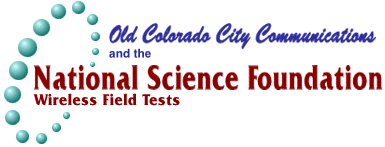
|
Voice 719.636.2040 · Fax 719.528.5869 ·Wireless Web http://wireless.oldcolo.com | ||
|
|
             |
Progress Report 15October 5th, 1997
What Hath Roger Wrought What is the most important finding of this NSF Wireless Field Test for Education Project so far? That without a local champion for trying to make the new wireless technologies work in a school or college, that school or college will remain with the more costly security blanket of telco-provided fixed wires. A corellative finding, is that few school administrations really care about the cost of telecommunications. For all the responsibility Superintendents have for managing the budgets of schools - the matter of data telecommunications is so arcane that they can count on disinterest from School Board members and ignorance by the taxpaying public. So a savings - to the taxpayers - of wireless over wired, which in some cases is as low as one-fifth the wired costs, isn't high on their priority list. As long as the public and the board thinks that the District is operating in the most cost-effective manner, the potential savings of advanced wireless - in spite of its very interesting educational reach 'beyond wires' will remain underutilized. And the funding by the Universal Service Fund will only make matters worse. For its 'free money' isn't it? One Bright Light So it has been encouraging and instructive to watch what has grown out of the very small NSF Wireless project started 18 months ago, in giving one 5th Grade Classroom at Evans Elementary School in Alamosa, Colorado a low speed (56Kbps) wireless link to nearby Adams State College, and thus access to the Internet by one MacIntosh computer operated by the then teacher Roger Quintanilla in that one classroom. Where Roger's primary aim was better education for his kids, not, primarily, economics. But he saw the potential, and so did other peer teachers who noticed the effect on children whom he had connected up for the serious purpose of look-up research for their classwork. And the fact that the 'connection' to the Internet was costing the school nothing (with the only cost to the NSF of a one time $2,500 in two radios and antennas) not being lost on Wally Herrera, the Principal, who backed Roger's effort to put the small school into the future. For now, less than a year later the entire Evans Elementary school, in 24 classrooms, and at 8 other administrative locations is connected by that same slender wireless link, between the School and the terminal server in the Computer Center of Adams State College, to the Internet. It is being used both by teachers for their own research and class preparation, and by the young students. The school used about $8,000 in its allocated 'technology budget' to acquire a network router, then a LAN server, then LAN wire the classrooms, then buy an Ethernet card for at least one classroom Mac, do a little training and - voila - all classes had a link from inside their own classroom, to the Internet. And even, cleverly, since our NSF grant could not properly also pay for individual email accounts, and the college could not justify it, all have a 'telnet' link to a community BBS where anyone can have a free email account. Except they reach it through the net, not via dial up modem. Not only economy, but ingenuity. As such, Evans Elementary still is the ONLY school in the Alamosa School District (7 schools, the largest of 14 districts in the San Luis Valley) connected to the Internet. And Roger Quintanilla has been made the District Technology Coordinator. An interesting educational-technological-administrative case of technological evolution. But other than dropping in for a photo-op at the 5th grade classroom with Roger - garnering feel-good local newspaper publicity - the District level officials can't see the implications of connecting up all their schools by no-cost wireless instead of forever-cost telephone lines. Or even more significantly seeing the educational possibilities, such as conducting field science in places where telephone wires can't go, permitting study any time any place by a tetherless, costless, connection, or anticipating a society where most educated people will carry mobile computing devices linked to the rest of the world in one wireless form or another. So the bottom-up experience of Evans Elementary School, where the only credit can go to Roger Quintanilla, reinforces our finding, stated in the first paragraphs above. Wireless takes pioneers. And they seem to be in short supply.
Dave Hughes


|

